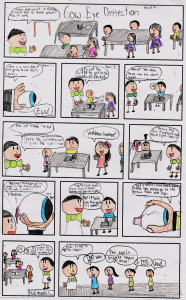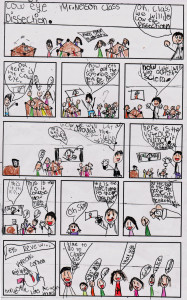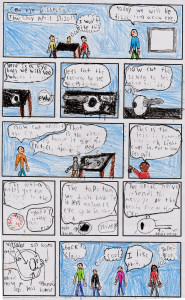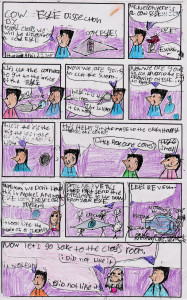Today was EdCamp Indy! I know you’d be amazed to know I talked about Comics in the Classroom, here’s the basics of my presentation including things that I had completely forgot since I was presenting off the cuff. reminding me that I really need to get a basic comics in education presentation done and put it on the cloud for just such occasions…
The Basics of Comic Creation-
Have the students consider using non-photo blue pencils. I recommend Prismacolor Verithin which can be found at most art supply stores or online. What this allows you to do is draw your artwork then ink over it (I use various sized Micron pens) and when you scan your artwork (in black & white- bitmap) the blue line disappears so it’s like having a magical eraser. You can introduce the concept of chromakey to older students at this time. Many companies produce “
comic book paper” which has the margins in blue line.
Right now I use Photoshop Elements to color and add words to my comic- it is fairly inexpensive (comes free with most scanners). “
Comic Life” is a great place to start and is available in Mac or PC (Learn something new every day) if you want to discuss balloon placement and layout since you can use photographs.
Manga Studio was also mentioned as a PC program for comic creation.
But I Can’t Draw!-
Just like any skill, drawing is something that comes with time and practice. The more you do anything, the better you get. My suggestion to start would be to use
Mark Kistler’s Draw Squad in your classroom for some quick drawing lessons. These are basic and can replace a day or two of penmanship lessons in the lower grades since it will actually help the students gain more fine motor control than just making a page of lower case d’s. There are 180 lessons in the book so it fits almost perfectly with a school year. He also has switched to
lessons online which shows just how old I am, I used Mark Kistler with my first graders. For real simple basics try
Ed Emberly books. For specific characters you can always use some the
Walt Foster “How to Draw” books. For classic Superheroes
How to Draw Comics the Marvel Way or Ty Templeton’s
How to Draw the DC Universe (unfortunately some of these might be out of print and therefore really pricey).
As for putting together a comic look at
Comic Book Design by Gary Spencer Millidge
Project Ideas-
You can start with something simple like taking a scene from a story and having the students recreate that in comic book form. As readers they will need to focus on the details in the descriptions so those are included in the illustration. What color was Laura’s dress? her hair? What happened when she filled her pocket with the smooth rocks from the shore of the lake? All of these need to be included to help tell the story.
Go to Unshelved.com and look at the entries in their
book club while as this became popular they added more reviews many are still done in
Comic Book Form like these examples from
Gregor the Overlander or
The Lightning Thief . Have the students do a comic form review of a book.
Have them use a comic to illustrate a science experiment or a scientific principle.
One school I work with has their 6th graders create a superhero based on the powers and abilities from an animal adaptation. The students then create a secret origin and draw the comic version, sharing it with other students at a school “Comic-Con.”
Resources-
Reading With Pictures– Online 501c3 promoting comic books in the classroom. The group has an online community for sharing lessons. After the success of their Kickstarter campaign for their Anthology, they have completed another campaign for the “Graphic Textbook” which should be available in late 2013. The textbook is an experiment in how to use comics to deliver classroom content. It includes such stories as “Abraham Lincoln: Action President, and a brief explanation of Newton’s laws of motion.
Diamond Bookshelf– the online (and print newsletter from Diamond Comics which is the company that distributes comics to all those comic shops everywhere. The newsletter is focused on the benefits of comics in libraries and classrooms.
Classroom Comic Library elementary to middle school (or at least a start)-
Use the
A Parent’s Guide to the Best Kids Comics as another resource or find your nearest comic shop and chat with them.
Bone by
Jeff Smith
Amelia Rules by
Jimmy Gownley
Mouse Guard by
David Petersen Legends of the Guard is a great way to look at how various writers and artists deal with working in the same “universe”
The Wizard of Oz by Eric Shanower &
Skottie Young
The Dreamland Chronicles by Christian Scott Salva This is originally a webcomic so you can read the entire thing online.
Little Guardians by Ed Cho & Lee Cherolis Also a web comic Ed & Lee are from Indianapolis and I’m sure would love to chat with kids about the process.
Solution Squad by Jim McClain & Rose McClain Jim is a middle school math teacher who uses his heroes to help his students understand math concepts. He has done some great presentations on using comics in the classroom.
-I know a lot of this is in the genre of fantasy… sue me, it’s what I like.
Questions? Anyone? Anyone? Bueller?-
I have addressed a few of the questions already but one that came up that needs to be addressed was “Do you let your reluctant readers read comics?” While many people would say “No,” I have a different viewpoint in my classroom. When the year starts off and I give them tour of the classroom we stop at the graphic novel section of my classroom library and I let the students know the rules of what you can and cannot read in the classroom. Comics BOOKS are fine reading material, comic STRIPs… not so much. A comic book follows the rules of any story- there are characters, setting, plot, and other pieces determined by the specific genre of the piece… a comic STRIP, not so much. A comic STRIP (Garfield, Calvin & Hobbes, etc.) is kind of like reading a joke book. Three panels then the punchline… so unless you are working on just phonics, sequencing, or vocabulary skills, a student isn’t going to get anything out of it. A comic book, or trade paperback, encompasses a story arc, and deals with things I can talk to the student about in a conference. Orson Scott Card once told the story of when he was a graduate assistant (and I paraphrase) Everyone else was using great works of literature in their classes, he looked at what the students needed to know and created a reading list in which he could teach those topics… instead of
Hamlet he had the class read
The Princess Bride. The students weren’t bogged down by the language and actually could see the concepts he wanted them to know. If I want my students to understand the “Heroes Journey” I won’t have 4th graders read
Beowulf, but I might have them read
Gregor the Overlander which is engaging to them and has the same concepts or maybe
Binky the Space Cat is an even better choice to start off with.
So What do I do Next?-
Go out to
your local comic shop and talk to them about what they think would be good ideas for your classroom or library. Ignore the concept of “Comic Book Guy” from the Simpson- if he exists his comic shop is soon to go bankrupt.
Remember to celebrate
Free Comic Book Day the first weekend in May and the little known
Halloween Comicfest– it happened last year, haven’t heard yet about it going on this year.
Check out your local Comic Book Convention!
Fort Wayne has one,
Kokomo has one,
Indianapolis is getting one in March. This is just a sampling of what’s available.
Just remember- to check out every comic you put in your library, just because it’s a comic doesn’t mean it is safe for your classroom. Only you know what your community will allow.
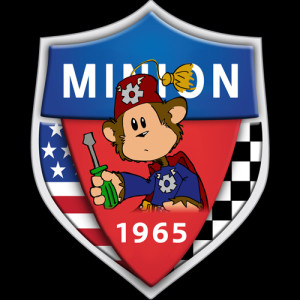 OOK! Up in the sky! It’s a bird! It’s a drone! It’s MINIon #1965! My classroom is just starting (after a few false starts) its end of year unit on Fantasy which heavily relies on a study of comic books. In the end I hope the class will cosplay their own characters, but what should I dress up as? In the past when asked to attend comic book related events at school, I tend to go with the “fanboy” look or what I wear at a comic-con, but since I’m kind of in charge of a group I figured I need to model correct superhero attire. So I’m thinking about going as “The MINIon” my superpower being to manipulate technology and not be afraid to push buttons… it might work, but then again I might change my mind or the costume colors because I can’t find the right shoes.
OOK! Up in the sky! It’s a bird! It’s a drone! It’s MINIon #1965! My classroom is just starting (after a few false starts) its end of year unit on Fantasy which heavily relies on a study of comic books. In the end I hope the class will cosplay their own characters, but what should I dress up as? In the past when asked to attend comic book related events at school, I tend to go with the “fanboy” look or what I wear at a comic-con, but since I’m kind of in charge of a group I figured I need to model correct superhero attire. So I’m thinking about going as “The MINIon” my superpower being to manipulate technology and not be afraid to push buttons… it might work, but then again I might change my mind or the costume colors because I can’t find the right shoes.  OOK! Up in the sky! It’s a bird! It’s a drone! It’s MINIon #1965! My classroom is just starting (after a few false starts) its end of year unit on Fantasy which heavily relies on a study of comic books. In the end I hope the class will cosplay their own characters, but what should I dress up as? In the past when asked to attend comic book related events at school, I tend to go with the “fanboy” look or what I wear at a comic-con, but since I’m kind of in charge of a group I figured I need to model correct superhero attire. So I’m thinking about going as “The MINIon” my superpower being to manipulate technology and not be afraid to push buttons… it might work, but then again I might change my mind or the costume colors because I can’t find the right shoes.
OOK! Up in the sky! It’s a bird! It’s a drone! It’s MINIon #1965! My classroom is just starting (after a few false starts) its end of year unit on Fantasy which heavily relies on a study of comic books. In the end I hope the class will cosplay their own characters, but what should I dress up as? In the past when asked to attend comic book related events at school, I tend to go with the “fanboy” look or what I wear at a comic-con, but since I’m kind of in charge of a group I figured I need to model correct superhero attire. So I’m thinking about going as “The MINIon” my superpower being to manipulate technology and not be afraid to push buttons… it might work, but then again I might change my mind or the costume colors because I can’t find the right shoes. 

